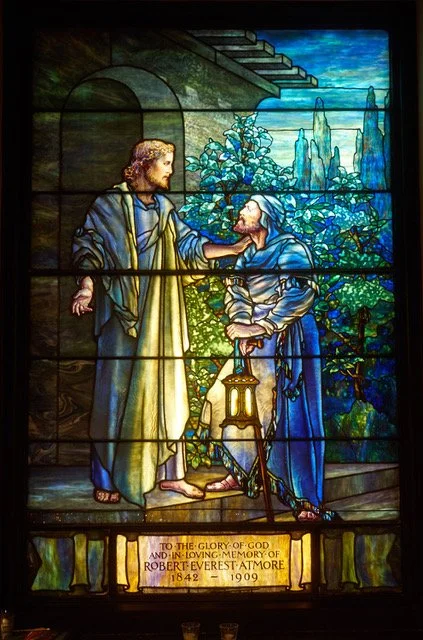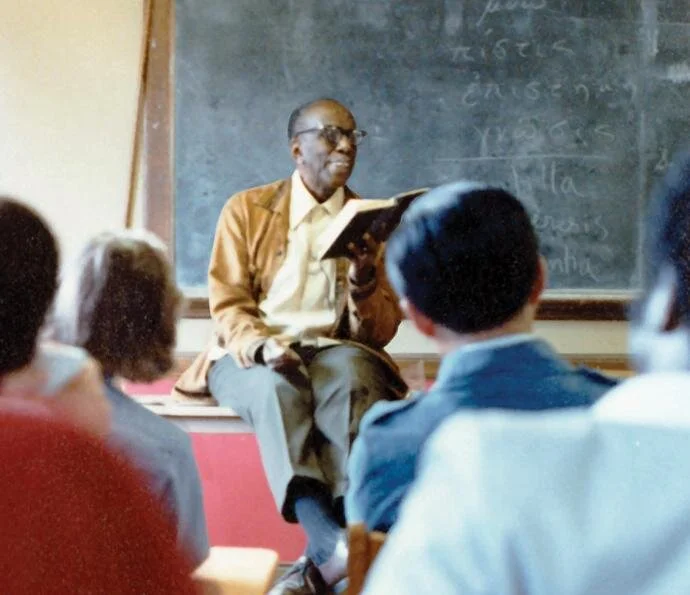The Burd Children’s Memorial, Part III: How One Memorial Participates in St. Stephen’s Today
In Part II, I proposed that the Burd Children’s Memorial of 1849-53 opened new religious options today. Quite so.
Yet it’s taken me ages to realize how those options emerged in dialogue with changes to the church, putting into play the Memorial’s unexplored nuance and versatility. So we start with the relevant past.
Beginning in the late nineteenth century, the Memorial’s guises shifted as St. Stephen’s expanded around it.
Its ambassadorial role for those buried nearby gained poignant power with Furness’ 1878 additions that obliterated the remaining churchyard (see Part I). The transept to the east connected by a door drew the side chapel into the church’s worship space. The departed beneath the floor disappeared from collective memory with time, however, as the Memorial’s guise as messenger of the divine covenant with us and promise of our eventual eternal reunion gained strength.
That message within the worship space intensified with especially radical physical changes to the church in 1888. The rector, The Rev. Dr. Samuel D. McConnell, proposed a new building for the “unoccupied” ground to the north “for carrying on the work of the Parish” on-site, rather than in a property many blocks away that they must vacate (Vestry Minutes, Feb. 6, 1888).
Yes, the word “unoccupied” shocked me when I discovered it last week. But to stick to our story here, the result was George C. Mason Jr.’s three-story Parish House that today wraps around and over the Burd Children’s Memorial.
North and west façade of St. Stephen’s showing the Burd Children’s Memorial Chapel, from the Illustrated New [NY], July 9, 1853, 14
F. Gutekunst, photographer, north and west façade of St. Stephen’s with the Mason Parish House and Furness transept (far left), c. 1890
Thus absorbed into the church, the Memorial shifted from an otherworldly vision from the churchyard into an accessible site for private prayer within the church especially in crisis: Note this undated newspaper clipping that records informal prayer on Good Friday at the Memorial during the Depression (probably April 1939).
Though the broader community of the buried departed may have been lost to memory, the Memorial’s identity as an actual tomb may have enhanced its authority in the life-to-afterlife story especially up close, where the inscription on the monument base speaks of actual burials beneath. Here, you stand on the mortal threshold.
Those elements all contributed to the role of the Burd Children’s Memorial in the newest chapters. The Memorial quietly became a crucial player in the church’s return to life in 2017. A new general vision ensued: ‘The Open Door,’ blazoned in an atypical view of the church on our Facebook page.
St. Stephen’s now welcomes all without a traditional congregation. The Open Door vision intensified the church’s commitment to the fluid, diverse stream of fellow pilgrims through life in this church. That Open Door not only signals invitation to those outside; it states the church’s “outward-looking” engagement with life and those beyond.
Symbolic doors between traditional church activities flew open, blessed by church decoration whose messages gained new life in the Here and Now. Enabled by the remodeling of the sanctuary in 1989, when portable chairs replaced the historic box pews, worship shared its space with new programs for the neighborhood needy, which typically proceed elsewhere (parish annexes or basements). Those involved in such programs at St. Stephen’s kept company with Dorcas, biblical embodiment of Christian generosity glowing overhead within a stained-glass window—and the Burd Children’s Memorial that broadcast God’s approval of sibling love, metaphor for earthly support for one another.
Furness Burial Cloister during the July 4 Open House
In 2019 St. Stephen’s completed its most dramatic statement about its Open Door: Furness’ transept, transformed, as described in Part 1, into the Furness Burial Cloister to welcome those buried below.
At St. Stephen’s, the departed were restored and featured as never before, and unlike most other churches with church burials. We produced biographies of the onetime forgotten (planned for inclusion on the website), a form of resurrection like that of St. Stephen’s itself.
Rising amidst vaults now visible and accessible from the Cloister to the Parish House vestibule (with others still inaccessible under the Parish House), the Burd Children’s Memorial continues as the compelling voice for both sides of the mortal threshold and for the divine about faith, sibling love, and promised Resurrection.
The Memorial today further embraces, with equal compassion and hope, the needy from the streets, individuals in pain, and all seeking the divine.
That evolving role includes the virtual St. Stephen’s, through the Open Door of the internet so vital during pandemic lockdown.
With its many appearances during online services, the Burd Children’s Memorial has touched the global community drawn to St. Stephen’s in crisis. Let’s see where our shared journey takes us from here. Join us as you can!
— Suzanne Glover Lindsay, St. Stephen’s historian and curator









